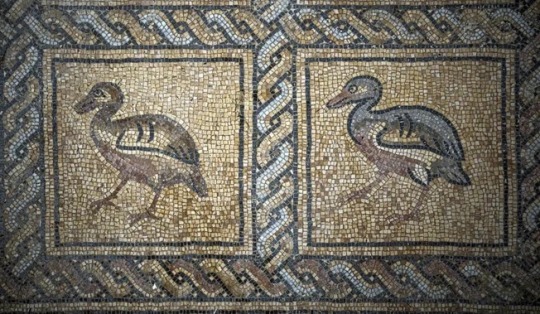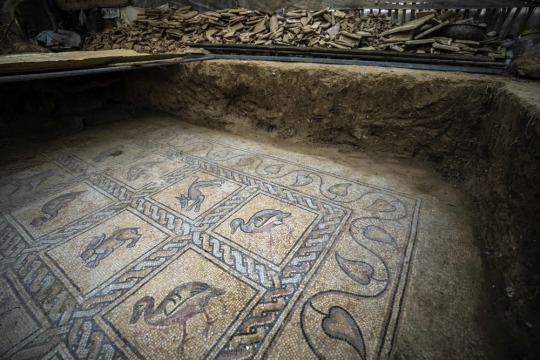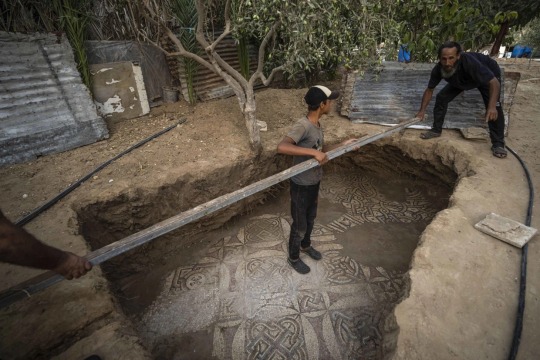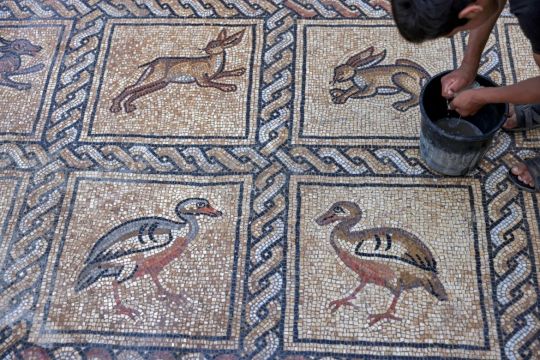#Palestinian Farmer Discovers a Rare Byzantine Mosaic in Gaza
Photo








Palestinian Farmer Discovers a Rare Byzantine Mosaic in Gaza
The mosaic, dating from between the 5th-7th centuries AD, was discovered by a local farmer whilst planting an olive tree. The significant discovery raises questions about the status of preservation efforts inside the besieged Palestinian enclave.
The Ministry of Tourism and Antiquities in the Gaza Strip announced on Friday "a major archeological finding"—the discovery of a stunning Byzantine mosaic. Hamas says it will issue an official statement providing additional details in the next few days.
The mosaic floor, dating from between the 5th-7th centuries, was discovered a few months ago inside the Bureij refugee camp in central Gaza, approximately 1km from the Israeli border.
Earlier today, the Associated Press shared photos of the site and reported that a local farmer uncovered the mosaic whilst planting an olive tree, when his spade hit a hard surface. The farmer and his son started digging. Three months later, they uncovered the mosaic.
Archeologists claim that this is one of the most significant findings ever discovered in the Gaza Strip. "These are the most stunning mosaic floors ever discovered in Gaza, in terms of the richness of the graphic representation and the complexity of the geometric layout. We have never seen a mosaic boasting such rich colors in Gaza before", says Rene Elter from the French School of Biblical and Archeological research in Jerusalem.
According to the photos, the mosaic features animal depictions, and appears to be well-preserved. A little damage is visible in some areas, caused by roots of olive trees planted at the site in previous years. The farmer who dug up the mosaic covered it with a large sheet and refuses to be identified before the official unveiling. In a chat with the Associated Press, he expressed his hope for some financial reward for his discovery.
The discovery of this archeological treasure brings to the fore the difficult and complex status of cultural heritage and preservation efforts in the Gaza Strip. A situation resulting from the continual conflict with Israel, and not helped by Hamas' own neglect of preservation efforts in some cases. Archeological artifacts in Gaza—one of the most densely populated areas in the world—are at risk due to budgetary considerations, development issues and a lack of sufficient local expertise and awareness. In addition, the occasional looting of artifacts by locals hardly helps the situation, and the destruction of sites is at times deliberately encouraged by the authorities.
In 2017. Hamas operatives completely destroyed significant portions of remains of the 4,500-year-old Bronze Age city of Tel Es-Sakan, to make way for new construction projects. As far as Israel is concerned, it also confiscated a large amount of artifacts from Gaza, during the years of its direct rule. One of the most prominent culprits was former Defense Minister and military chief Moshe Dayan.
The Gaza Strip was once a thriving and important crossroads and trade route, connecting the Levant with Africa and Asia. As a result, it has accumulated significant archeological treasures over the course of the last 5,000 years: from the Bronze age and times of the Caliphate, through to the Ottoman Empire and the days of British mandate in the 20th century.
Last June, a large ancient Roman necropolis (a burial site) was discovered in Gaza, dating from the 1st-2nd centuries AD. It was discovered by tractors in Jabalia, in northern Gaza, whilst digging foundations for concrete structures as part of a reconstruction project.
In 1999, the Saint Hilarion Monastery was discovered about ten kilometers south of Gaza city. The monastery is part of a sprawling 4.5 acres structure, built atop the alleged birthplace of Saint Hilarion, a Christian saint who lived in the area in the 4th century, considered to be a founding father of cenobism in the holy land. The website dedicated to the site features images of walls and foundations of two churches, a cemetery, bath houses, a baptism chamber and mosaic floors.
In 1996, another 5th century Byzantine church was discovered in Jabalia.
#Palestinian Farmer Discovers a Rare Byzantine Mosaic in Gaza#5th-7th centuries AD#archeology#archeolgst#mosaic#ancient mosaic#ancient artifacts#history#history news#ancient history#ancient culture#ancient civilizations
345 notes
·
View notes
Photo

Palestinian farmer discovers rare Byzantine-era mosaic while planting olive tree in Gaza
1 note
·
View note